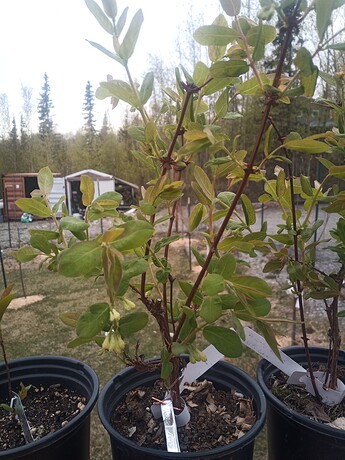I think I have at least one dormant cutting that’s going to make it, but better hang on, as there’s plenty time for losses.
Probably right, but I have a few hardwood cuttings that might still be alive, so we’ll see. I’ll take some new softwood cuttings in a few weeks. I tried this last year, but let them all dry out and die, unfortunately. I’m going to keep a closer eye on them this year, but I just don’t have time to baby them.
I’ve seen people use disposable water bottles with media in them attached to a branch to root a clone. This might be a good method to use on a well developed bush.
Honestly, I’ve only used hardwood cuttings for honeyberry propagation. The success rate has been high.
I suspect the reason so many honeyberries have been placed into propagation prohibited categories (via patents or by private agreements) or popularized under trademark names is that they’re so easy to propagate so the breeders were trying to find ways to ensure they could monopolize sales despite the ease with which any nursery could actually propagate them.
?
If you can get 70 to 95% takes bare root…you can start a business.
I do have a business. 
Good for you.
I also do, but not in propagating hard to root bushes. 
Honestly, I consider honeyberries to be far easier to propagate than most of my other plants.
I do understand green summer cuttings rooted under mist…but a high percent of dormant…haven’t observed that.
Currants or forsythia bushes are near 100%…but not honeyberries.
Maybe it’s location related. For me, dormant honeyberry cuttings have rooted at about the same rate as red currants with no special care. No misting either. Just plant the dormant cuttings in soil over winter with or without rooting hormone. I would say I probably stick them so about two thirds of the cutting length is submerged in soil.
There possibly could be a climate factor…afterall moss on tree trunks isn’t that common here.
But I’ll be encouraged to keep trying for a higher % – I do all mine in shaded areas outdoors.
I stuck some hinoki cypress in November and have one. A flat of holly, and have 5 or 6 or about 1/4th.
Currants, about 90%. Figs near 100%. Forsythia near 100%.
Apples, cherries…0% so far.
And I did stick a flat of honeyberries in Feb. but it’s far too early to tell. Had one make it out of over a dozen last year.
Same here. Have you ever taken hardwood cuttings this late? I have been sick off and on and wasn’t able to take any cuttings between that and trying to keep up with my off-the-farm-job. I think I might try to take a dozen or so cuttings today or tomorrow and stick them in my outdoor prop bed just to see what happens.
Edit: I decided to stick 5 cuttings. 4 Aurora (one looked pretty bad, so I’d be surprised if that one takes) and 1 that I think is Early Blue. We’ll see what happens.
“This late” is really location dependent. Where I’m at the honeyberries already have developing fruit and are in full growth mode.
Good point, lol. Not sure why I was thinking that you were in my zone. What zone are you in?
PNW 8a.
After 5 years, anything exciting to report on?
Follow up on my post from last year, reproducing haskaps in Alaska. Basically of the two modalities, soft wood or hard wood. Because of our short season, hardwood cuttings in the later winter is the winner.
This is a plant from softwood cuttings taken in mid July 2021:
And here is a plant, from hardwood cuttings, taken during dormancy in late March 2021:
Haskaps have two grow spurs each year; the early spring initial growth and a second one in August, after fruiting. If you do a green cutting in the summer the plant barely experiences one growth cycle, just enough to put out some roots. It doesn’t have a second growth cycle until the next spring. When you start with dormant hardwood, the plant has more energy stored on the larger cutting and it gets a chance to do two growth cycles before going dormant. As you can see in the photo that’s the push of the third growth cycle.
At least for our painfully short growing seasons there is just no point on doing green cuttings mid season; you may as well wait until the next early spring and propagate from hardwood cuttings. There is a higher failure rate but the plants will end up ahead of the game compared to ones from green cuttings from the summer prior.
Here’s a row of seedlings I started awhile back, now bearing age and full of bloom. I look forward to evaluating the fruit these produce
Very very nice!
I’ve ate a couple of my honeyberries over the weekend. Indigo Treat isn’t all that tasty.
Maybe you’ll get some real good ones among your seedlings.




